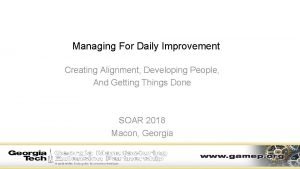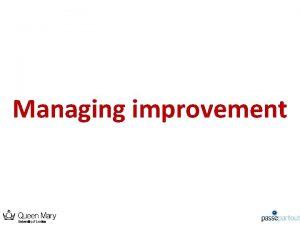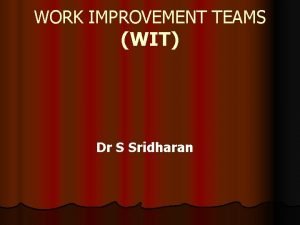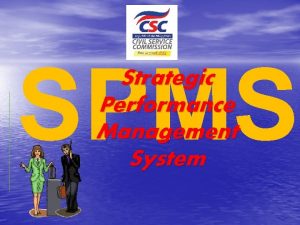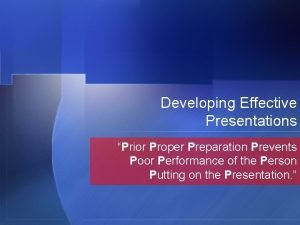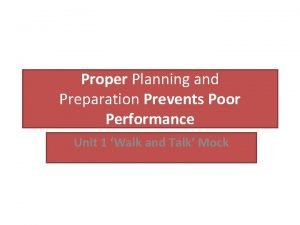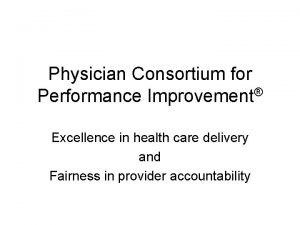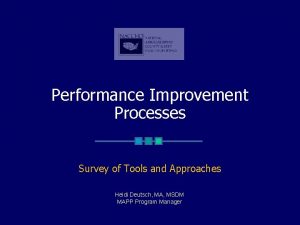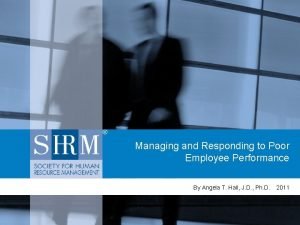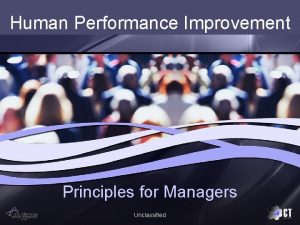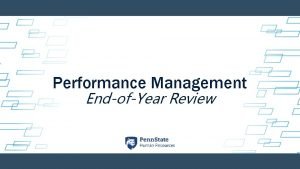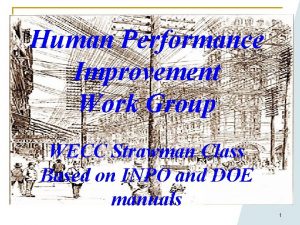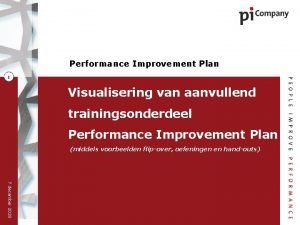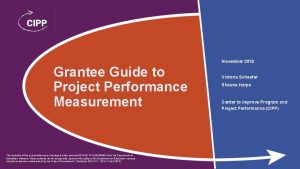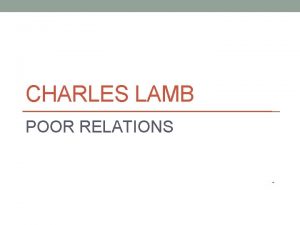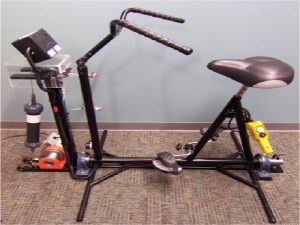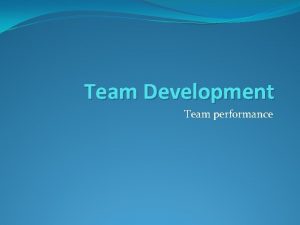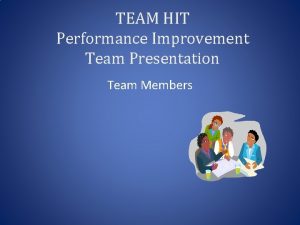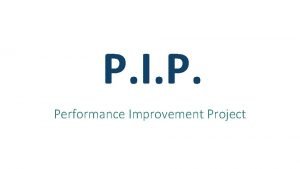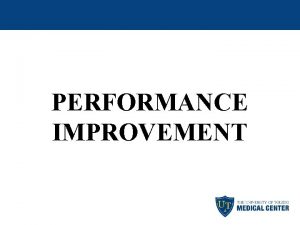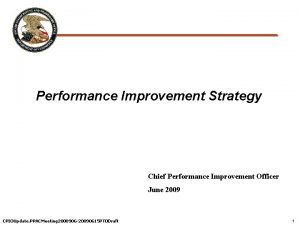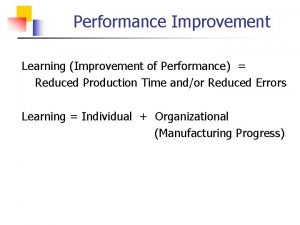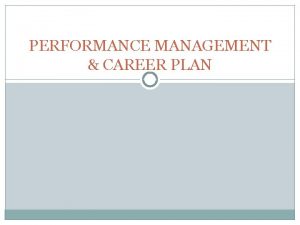Team Management Series Managing Poor Performance Performance Improvement

















- Slides: 17

Team Management Series: Managing Poor Performance (Performance Improvement Plan) UCP Central PA Supervisor Meeting December 18, 2014

Managing Poor Performance Training Objectives: 1. Define what a Performance Improvement Plan (PIP) is and identify when it should be used. 2. Identify key concepts and main components of the PIP document. 3. Understand how to develop, enforce and follow-through on administering an effective PIP. 4. Demonstrate ability to develop a PIP for a commonly encountered scenario.

What is a Performance Improvement Plan? ü A formal process used by supervisors to help employees improve performance or modify behavior. ü Identifies performance/behavioral issues needing correction and creates a written plan of action to guide the improvement/corrective action. ü Can be used as part of the progressive discipline process. ü Goal is to assist the employee in becoming successful. ü ONLY WORKS when the supervisor regularly provides feedback to the employee regarding performance and follows-through on support actions!

Performance Improvement Plan (PIP) Key Concepts: ü Must be achievable and relevant, outlines authority and accountability, can be evaluated/measured, is fair, holds people to account (EMPLOYEE & SUPERVISOR). ü Supervisor, with employee input, develops the plan using S. M. A. R. T. Goal (Specific, Measurable, Attainable, Realistic, Time-Bound). ü Set a target date for completion – plan length varies, 60 days is typical. ü Be transparent and clear about consequences if the goal is not met.

Performance Improvement Plan 1. 2. Area Needing Improvement a. State the performance/behavior to be improved. b. Be specific and cite examples. c. Copy of UCP Personnel Policies handy. Performance Standard a. State the work performance expectation. b. Set expectation it needs to be performed on a consistent basis. c. Performance Standard is the desired outcome.

Performance Improvement Plan Action Steps a. Identify specific and detailed action steps needed to correct the issue. b. Make the steps measurable. Build in milestones. c. Involve the employee in creating action steps. 4. Responsibilities a. Specify who is responsible/accountable for each step. i. Employee, Manager (or both), other assigned staff. HOLD YOURSELF ACCOUNTABLE! 3.

Performance Improvement Plan 5. Resources Needed a. Identify and specify the support and resources you will provide to assist the employee. i. 6. If not available, follow-up on need ASAP. Timeline a. Set and state the timeline/due date for each action step. b. Set the target completion PIP date.

Performance Improvement Plan 7. Review Meeting Date/s a. Schedule routine progress meetings. FOLLOW THROUGH! b. Communicate your plan for providing ongoing feedback to the employee. c. Specify possible consequences if performance standard is not met. Both parties sign and date – a signed copy is given to the employee. ü If employee refuses to sign, supervisor makes note of the refusal and should contact HR. ü Performance Improvement Plan. http: //humanresources. about. com. 2014.

PIP Progress Meetings: IMPORTANT to monitor and enforce the PIP!! Schedule and hold progress/accountability meetings. ü Use meetings to review action steps progress and milestone achievement. ü Be prepared by having completed supervisor action support responsibilities as agreed upon! ü Provide honest, fair feedback. ü Document employee and supervisor progress comments. ü Possibility of timeline extension if progress is slow.

PIP Completion Meeting: On PIP completion date, supervisor CHECKS one of the following: Ø Has satisfactorily met the expectations of the PIP completed on_____. Ø Has not yet satisfactorily met the expectations of the PIP but has shown some improvement: PIP is extended to ______. üREMEMBER to continue to meet and review on new end date. Ø Has not satisfactorily met the expectations of the PIP. Corrective disciplinary action is required. üProgressive Discipline/termination (Jan. training topic). *Send PIP copy to Human Resources.

PIP Scenarios Applying Supervisor Training

Scenario 1: Holding employees accountable for job performance. Jack works for Capital Home Care on a part-time basis and provides care for consumer Carol. Over the past 3 months, the following has occurred: Jack did not read the treatment plan notes thoroughly and missed the fact that Carol is having knee trouble and should limit activity. He took her on several walking-intensive outings. Jack has shown up late for his shift with Carol 3 times. Jack was observed texting on his phone and taking smoking breaks numerous times when he was on shift. Outline the key parts of a PIP for Jack.

Scenario 2: Holding employees accountable for administrative tasks. Sarah works with consumers in an Alternatives Program. During the past 6 months, the following has occurred: Sarah turned in her time sheets late 3 times. This resulted in a lot of time should have been attending to the consumers being spent talking with her supervisor (you) and with Payroll to make sure she received her pay. Sarah was given instructions about how to register on the ADP Employee Self-Service Portal. You also reminded her once. She never registered and keeps asking you to go in and print her pay statement for her. Sarah has forgotten to make entries in her assigned consumer’s case notes on 3 separate occasions. She had to go back a week later and try to make the entries from memory. Outline the key parts of a PIP for Sarah.

Scenario 3: Holding your managers/supervisors accountable. Rhonda is a House Manager who reports to you. You become aware that Rhonda is not being responsible in communicating key information to the employees at the Home. You forwarded Rhonda information on Open Enrollment along with instructions, dates for the information sessions, and dates that Open Enrollment begins and ends. You find out that she did not share this information and as Open Enrollment is closing several of the staff have not signed up for benefits. A few weeks ago you sent information on the new Pathways Program Open House to pass along to the staff. A few days after the event 2 of the employees told you they were never told about the new program or the Open House. Another employee called you because Rhonda has never shared job postings that she receives via email. This resulted in the upset employee missing out on applying for a job he would have been interested in. Outline the key parts of a PIP for Rhonda.

Scenario 4: Holding your supervisors accountable for administrative tasks. Michael is a Program Supervisor. He is great with the consumers but doesn’t like administrative tasks and often fails to complete them. Over the past 4 months, the following has occurred: Michael has turned in new hire paperwork to HR past the due date 3 separate times, resulting in both HR and Payroll scrambling to make sure his new employees were legally employed and paid on time. Michael has had 2 employee issues that required disciplinary action but he waited almost 2 weeks after the events to contact HR and try to come up with the warnings. Michael turned in performance reviews almost 6 months late for 4 employees. This resulted in back pay being owed and caused other salary reports to be incorrect. Outline the key parts of a PIP for Michael.

Scenario 5: Holding administrative employees accountable. Joe is an accountant who reports to you. You have had issues with Joe completing tasks in a timely manner as he seems to get consumed by the day to day demands of his job. During the past six months, the following has occurred: Joe has failed to make progress on a key fiscal project. He has not turned in the project plan as you required and keeps making excuses. Joe waited until the last minute to complete the analysis for a monthly reconciliation that has a deadline. This resulted in him having to work late at night on many occasions, which led to him complaining constantly to coworkers. You have observed Joe complaining about UCP, his job, the Finance Dept. , and his co-workers on numerous occasions, including during staff meetings. Outline the key parts of a PIP for Joe.

THANK YOU for your participation!
 Managing for daily improvement
Managing for daily improvement Managing improvement
Managing improvement Work improvement teams singapore
Work improvement teams singapore Opcr sample for lgu
Opcr sample for lgu Proper presentation prevents poor performance
Proper presentation prevents poor performance Kinlaw process
Kinlaw process Proper preparation prevents poor performance gd
Proper preparation prevents poor performance gd Performance improvement plan examples
Performance improvement plan examples Physician consortium for performance improvement
Physician consortium for performance improvement Performance improvement survey
Performance improvement survey Examples of performance improvement plans for employees
Examples of performance improvement plans for employees Human performance improvement principles
Human performance improvement principles Housekeeping performance improvement plan
Housekeeping performance improvement plan Questioning attitude human performance
Questioning attitude human performance Loopbaandadvies
Loopbaandadvies Call center performance improvement plan template
Call center performance improvement plan template Team spirit becomes team infatuation
Team spirit becomes team infatuation Team spirit becomes team infatuation
Team spirit becomes team infatuation
